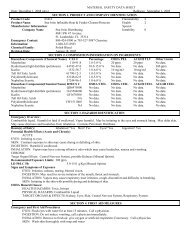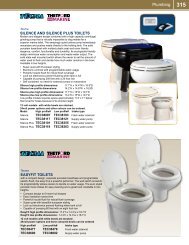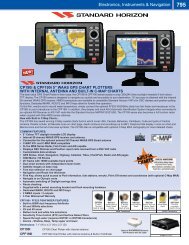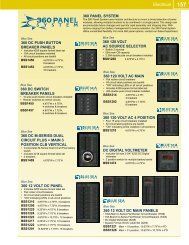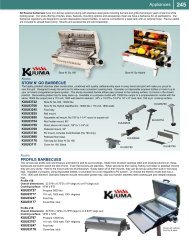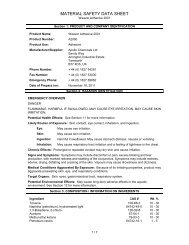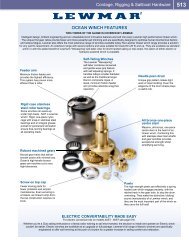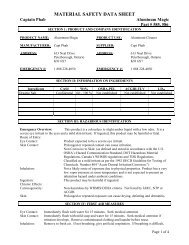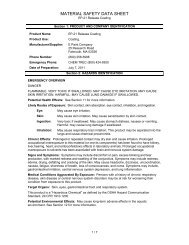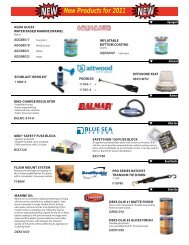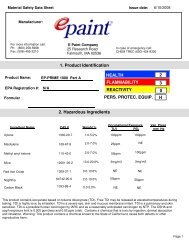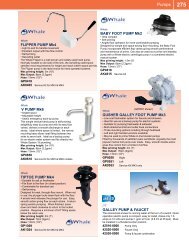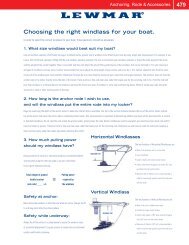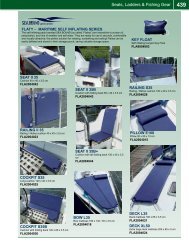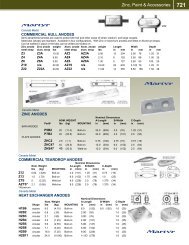MSDS for Fogging Oil - Codes 272,273 - Paynes Marine Group
MSDS for Fogging Oil - Codes 272,273 - Paynes Marine Group
MSDS for Fogging Oil - Codes 272,273 - Paynes Marine Group
Create successful ePaper yourself
Turn your PDF publications into a flip-book with our unique Google optimized e-Paper software.
SECTION 1 - MATERIAL IDENTIFICATION & USE<br />
Material Name: FOGGING OIL <strong>Codes</strong> <strong>272</strong> & <strong>273</strong><br />
Supplier: PHAB Ltd.<br />
Address: 613 Neal Drive<br />
Peterborough, Ontario.<br />
K9J 6X7<br />
Emergency Telephone #: 705 748-0436<br />
Chemical Name: Molecular Weight:<br />
Chemical Family: Petroleum Trade Name/Synonyms: n/a<br />
MATERIAL HEALTH & SAFETY DATA SHEET<br />
Chemical Formula: Petroleum based Material Use: Engine preservative<br />
SECTION 2 - HAZARDOUS INGREDIENTS OF MATERIAL<br />
(Key: > = Greater than; < = Less than)<br />
Approximate C.A.S.N.A. or "Exposure LD 50 / LC 50<br />
Hazardous Ingredients Concentration % U.N. Numbers Limits" Specify Species & Route<br />
Petroleum Distillate 10-30 64742-88-7 Vapor (LC 50 ) Acute<br />
1400 ppm 4 hours (rat)<br />
Liquefied petroleum gas 7-13 68476-85-7 Not available<br />
SECTION 3 - PHYSICAL DATA FOR MATERIAL<br />
Physical State: Liquid Specific Gravity: 0.848 Odour Threshold(ppm): Odour & Appearance: Petroleum solvent - amber<br />
Vapour Pressure (mm/Hg): 9.75 Vapour Density (Air=1): Heavier than air Evaporation Rate:n/a<br />
Boiling Point (°C):157 Freezing Point (°C): n/a<br />
Solubility in Water(20°C): Insoluble % Volatile (by volume): n/a pH: n/a Density (g/ml): 0.848 Coefficient of water/oil distribution: n/a<br />
SECTION 4 - FIRE AND EXPLOSION HAZARD OF MATERIAL<br />
Flammability: Yes. Flame extension of aerosol exceeds 45 cm.Canadian NFC - Level 3. Do not use in presence of open flame or spark.<br />
Means of Extinction: Dry chemicals. CO 2 or foam<br />
Special Procedures Do not place in hot water, near radiators, stoves or other sources of heat<br />
Flash point(°C) & Method: 42 TAG Upper explosion limit(% by volume): 6% Lower explosion limit (% by volume): 1.1%<br />
Auto Ignition Temperature(°C): n/a TDG Flammability Classification: Aerosols class 2.1 UN 1950<br />
Hazardous Combustion Products: CO, CO 2 , Sulfur oxides, smoke<br />
EXPLOSION DATA:<br />
Chemical Sensitivity to Impact: Avoid mechanical impact Rate of Burning: n/a Explosion Power: Yes Sensitivity to Static Discharge: Yes<br />
SECTION 5 - REACTIVITY DATA<br />
Chemical Stability : Yes Conditions:<br />
Incompatibility to other substances: Yes Substances: Strong oxidizing agents, strong acids, strong alkalis.<br />
Reactivity and under what conditions: Keep away from heat, sparks, open flame and all other possible ignition sources.<br />
Hazardous Decomposition Products: CO, CO 2 , Sulfur, smoke, fumes.
Page 2 Material Name: FOGGING OIL <strong>Codes</strong> <strong>272</strong> & <strong>273</strong><br />
SECTION 6 - TOXICOLOGICAL PROPERTIES OF PRODUCT<br />
Route of Entry:: Skin Contact: .....X............ Eye Contact:..X.................<br />
Inhalation :..X............ Ingestion:.....X........<br />
TLV Petroleum distillate TWA - 100 (ppm)<br />
Liquefied petroleum gas - TWA: 1000 CEIL: 1250 (ppm) TWA: 1800 CEIL: 2250 (mg/m 3 )<br />
Toxicity to Animals -- WARNING: THE LC50 VALUES HEREUNDER ARE ESTIMATED ON THE BASIS OF A 4-HOUR EXPOSURE.<br />
Acute toxicity of the vapor (LC50) : 1400 ppm (Rat) (Petroleum distillate)<br />
Chronic Effects on Humans: Prolonged or repeated skin contact may lead to dermatitis.<br />
Acute Effects on Humans: EYE CONTACT: May cause irritation, redness and tearing.<br />
SKIN CONTACT: May cause irritation, defatting, drying and cracking of skin.<br />
INHALATION: Excessive inhalation of vapours may be irritating to the nose, throat and respiratory tract and may cause<br />
headache and possible unconsciousness.<br />
INGESTION: May cause gastrointestinal irritation, nausea, vomiting and diarrhea. Aspiration of material into the lungs<br />
may cause chemical pneumonitis which can be fatal. Can be fatal if inhaled or ingested.<br />
This product may irritate eyes and skin upon contact.<br />
Synergistic materials: Not available<br />
Carcinogenicity: The ingredients of this product have not been listed as carcinogens by the National Toxicology Program (NTP).........<br />
Reproductive effects: Not available Teratogenicity:....Not available. Mutagenicity:. Not available.<br />
SECTION 7 - PREVENTIVE MEASURES<br />
Small Leak or Spill: Ventilate area and eliminate all sources of ignition. Absorb with an inert material and place in an appropriate waste disposal container.<br />
Personal Protective Equipment: Recommend safety glasses and chemical resistant gloves.<br />
Large Leak & Spill Procedure: Not applicable <strong>for</strong> aerosol containers.<br />
Protective Clothing: Not applicable <strong>for</strong> aerosol containers.<br />
Engineering Controls: Use under well-ventilated conditions.<br />
Precautions: Contents under pressure. Container may explode if heated. Direct inhalation of spray may be harmful<br />
Harmful or fatal if swallowed. Keep out of reach of children.<br />
Waste Disposal: Recycle to process, if possible. Consult your local or regional authorities. When container is empty, press button to release all pressure,<br />
then dispose of in garbage can.<br />
Handling Procedures & Equipment: DO NOT use in the presence of open flame or spark. Keep away from heat. Avoid breathing vapours or spray mists.<br />
If ingested, seek medical advice immediately and show the container or the label. Avoid contact with skin and eyes.<br />
After handling, always wash hands thoroughly with soap and water.<br />
Storage Requirements: Store in a cool, dry place. Do not place in hot water or near radiators, stoves or other sources of heat. Do not puncture,<br />
incinerate or store the container at temperatures over 50°C or in direct sunlight.<br />
Special Shipping In<strong>for</strong>mation: None<br />
SECTION 8 - FIRST AID MEASURES<br />
Skin: wash thoroughly with soap and water .If irritation persists get medical attention. Remove contaminated clothing and wash be<strong>for</strong>e reuse.<br />
Eyes: Flush eyes with plenty of water <strong>for</strong> at least 15 minutes, lifting upper and lower lids occasionally. If irritation persists get medical attention.<br />
Inhalation: Remove affected person to fresh air. If breathing is difficult, administer oxygen. If breathing stops give artificial respiration.<br />
Get medical attention.<br />
Ingestion: If swallowed, call a physician or poison control centre immediately. DO NOT induce vomiting. Aspiration of material into lungs due to vomiting may cause<br />
chemical pneumonitis which can be fatal.<br />
SECTION 9 - PREPARATION DATE OF M.S.D.S.<br />
TDG Road/Rail -- Aerosols, Class 2.1 UN 1950<br />
WHMIS: WHMIS Class A: Compressed gas.<br />
WHMIS ClassB-5: Flammable aerosol<br />
WHMIS Class D-2B: Material causing other toxic effects (TOXIC)<br />
Sources Used: Aerosol packager 's <strong>MSDS</strong>'s.<br />
Prepared by: Abe Kelly Phone #: 705 748-0436 Fax #: 705 876-6467 Date: January 1, 2006 Revision Date: December 1, 2006



